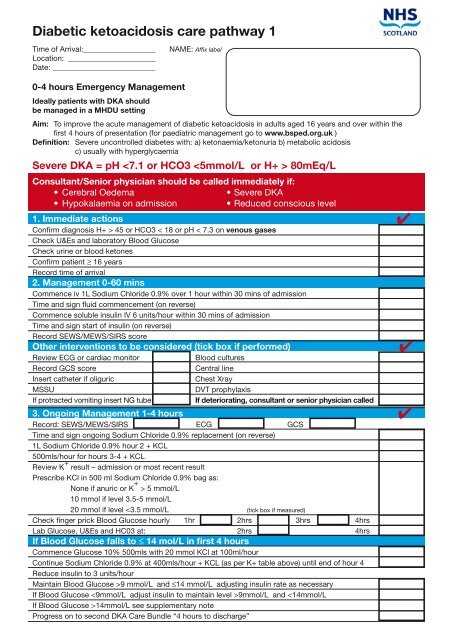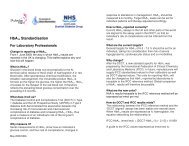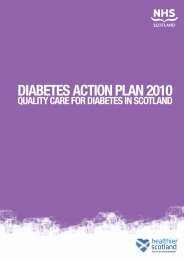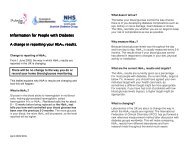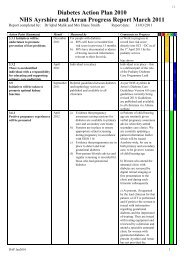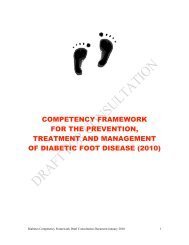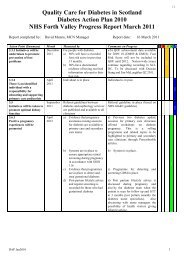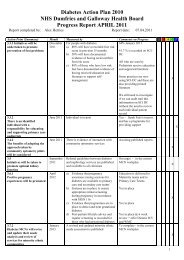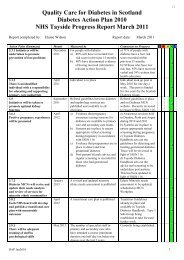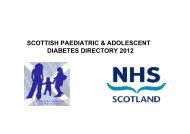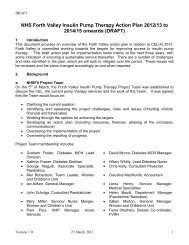Diabetic ketoacidosis care pathway 1 - Diabetes in Scotland
Diabetic ketoacidosis care pathway 1 - Diabetes in Scotland
Diabetic ketoacidosis care pathway 1 - Diabetes in Scotland
Create successful ePaper yourself
Turn your PDF publications into a flip-book with our unique Google optimized e-Paper software.
<strong>Diabetic</strong> <strong>ketoacidosis</strong> <strong>care</strong> <strong>pathway</strong> 1<br />
Time of Arrival:___________________ NAME: Affix label<br />
Location: _______________________<br />
Date: ___________________________<br />
0-4 hours Emergency Management<br />
Ideally patients with DKA should<br />
be managed <strong>in</strong> a MHDU sett<strong>in</strong>g<br />
Aim: To improve the acute management of diabetic <strong>ketoacidosis</strong> <strong>in</strong> adults aged 16 years and over with<strong>in</strong> the<br />
first 4 hours of presentation (for paediatric management go to www.bsped.org.uk )<br />
Def<strong>in</strong>ition: Severe uncontrolled diabetes with: a) ketonaemia/ketonuria b) metabolic acidosis<br />
c) usually with hyperglycaemia<br />
Severe DKA = pH 45 or HCO3 < 18 or pH < 7.3 on venous gases<br />
Check U&Es and laboratory Blood Glucose<br />
Check ur<strong>in</strong>e or blood ketones<br />
Confirm patient ≥ 16 years<br />
Record time of arrival<br />
2. Management 0-60 m<strong>in</strong>s<br />
Commence iv 1L Sodium Chloride 0.9% over 1 hour with<strong>in</strong> 30 m<strong>in</strong>s of admission<br />
Time and sign fluid commencement (on reverse)<br />
Commence soluble <strong>in</strong>sul<strong>in</strong> IV 6 units/hour with<strong>in</strong> 30 m<strong>in</strong>s of admission<br />
Time and sign start of <strong>in</strong>sul<strong>in</strong> (on reverse)<br />
Record SEWS/MEWS/SIRS score<br />
Other <strong>in</strong>terventions to be considered (tick box if performed)<br />
Review ECG or cardiac monitor Blood cultures<br />
Record GCS score Central l<strong>in</strong>e<br />
Insert catheter if oliguric Chest Xray<br />
MSSU DVT prophylaxis<br />
If protracted vomit<strong>in</strong>g <strong>in</strong>sert NG tube If deteriorat<strong>in</strong>g, consultant or senior physician called<br />
3. Ongo<strong>in</strong>g Management 1-4 hours<br />
Record: SEWS/MEWS/SIRS ECG GCS<br />
Time and sign ongo<strong>in</strong>g Sodium Chloride 0.9% replacement (on reverse)<br />
1L Sodium Chloride 0.9% hour 2 + KCL<br />
500mls/hour for hours 3-4 + KCL<br />
Review K + result – admission or most recent result<br />
Prescribe KCl <strong>in</strong> 500 ml Sodium Chloride 0.9% bag as:<br />
None if anuric or K + > 5 mmol/L<br />
10 mmol if level 3.5-5 mmol/L<br />
20 mmol if level 9 mmol/L and ≤14 mmol/L adjust<strong>in</strong>g <strong>in</strong>sul<strong>in</strong> rate as necessary<br />
If Blood Glucose 9mmol/L and 14mmol/L see supplementary note<br />
Progress on to second DKA Care Bundle “4 hours to discharge”<br />
✔<br />
✔<br />
✔
Fluid (potassium) prescription sheet<br />
DATE FLUID Vol (ml) Duration Signature Serial No Time Given<br />
Batch No begun by<br />
POTASSIUM Dose (mmol)<br />
A Sodium Chloride 0.9% 500ml 30m<strong>in</strong>s<br />
B Sodium Chloride 0.9% 500ml 30m<strong>in</strong>s<br />
C Sodium Chloride 0.9% 500ml 30m<strong>in</strong>s<br />
D Sodium Chloride 0.9% 500ml 30m<strong>in</strong>s<br />
E Sodium Chloride 0.9% 500ml 60m<strong>in</strong>s<br />
F Sodium Chloride 0.9% 500ml 60m<strong>in</strong>s<br />
G<br />
H<br />
Once Blood Glucose 14 mmol/L<br />
3units/hour when<br />
Blood Glucose ≤14 mmol/L<br />
Supplementary notes<br />
1. Guidance on bicarbonate<br />
Do not use bicarbonate.<br />
2. Potassium Replacement<br />
KCL should not normally be adm<strong>in</strong>istered at a rate of greater than<br />
20mmol/hour<br />
3. WBC Count<br />
The WBC count is often raised <strong>in</strong> DKA and antibiotics should only<br />
be adm<strong>in</strong>istered if there is clear evidence of <strong>in</strong>fection.<br />
4. Blood Glucose >14 mmol/L<br />
If Blood Glucose rises >14mmol/L do not stop glucose, adjust<br />
<strong>in</strong>sul<strong>in</strong> to ma<strong>in</strong>ta<strong>in</strong> level between 9 and 14 mmol/L<br />
5. Signs of Cerebral Oedema<br />
Children and adolescents are at the highest risk of cerebral<br />
oedema. Consider if:<br />
• Headaches<br />
• Reduced conscious level.<br />
• Monitor<strong>in</strong>g for signs of cerebral oedema should start from the<br />
time of admission and should cont<strong>in</strong>ue until up to at least 12<br />
hours after admission<br />
• Adm<strong>in</strong>ister IV mannitol (100mls of 20% over 20 m<strong>in</strong>utes) or<br />
dexamethasone 8mg (discuss with Consultant)<br />
• Undertake CT scan to confirm f<strong>in</strong>d<strong>in</strong>gs;<br />
• Consider ITU (check arterial blood gases)<br />
• If there is a suspicion of cerebral oedema or the patient is not<br />
improv<strong>in</strong>g as expected /with<strong>in</strong> 4 hours of admission, call Consultant.<br />
6. Laboratory Blood Glucose Test<strong>in</strong>g<br />
It is reasonable to use a po<strong>in</strong>t-of-<strong>care</strong> blood glucose meter to<br />
monitor blood glucose level if the previous laboratory blood<br />
glucose value is less than 20 mmol/L .<br />
7. Insul<strong>in</strong> Management<br />
Insul<strong>in</strong> should be prescribed, beg<strong>in</strong>n<strong>in</strong>g at 6 units/hour. Rate<br />
will generally be reduced with time depend<strong>in</strong>g on cl<strong>in</strong>ical circumstances,<br />
presence of long act<strong>in</strong>g <strong>in</strong>sul<strong>in</strong> and to avoid a fall of >5mmol/L per hour<br />
as rapid falls <strong>in</strong> Blood Glucose may be associated with cerebral oedema.<br />
Do not stop glucose once started


